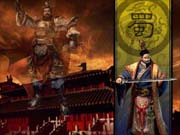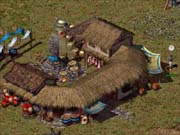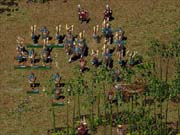Object Software's Dragon Throne: Battle of Red Cliffs is the sequel to Fate of the Dragon. Both are real-time strategy games that take place during the legendary Three Kingdoms era in ancient China. Like Fate of the Dragon before it, Dragon Throne is a strategy game that uses somewhat simple 2D graphics and has full speech in Chinese. And like Fate of the Dragon, Dragon Throne is a decent enough game, but there are better real-time strategy games that you can spend your time and money on.

Dragon Throne takes place in the ancient China made famous by Luo Guanzhong's Romance of the Three Kingdoms, a historical novel that chronicles the battle for control of China between three of its most powerful warlords: Liu Bei, Sun Quan, and Cao Cao. Then again, so did Fate of the Dragon. Dragon Throne uses the same game engine and graphics as the previous game--you'd probably have trouble telling the two games apart at a glance. In both games, as with most other real-time strategy games, you start with a group of peasants, whom you command to gather resources and construct buildings that will let you gather an army to send after your opponents' peasants, buildings, and armies. And just like in Fate of the Dragon, the 2D graphics of Dragon Throne seem a bit plain--all of the game's units, including peasants, soldiers, and heroes, are tiny onscreen. The sequel's buildings, which include peasant farms, weapon workshops, and infantry barracks, are fairly detailed, but everything in the game is drawn using a drab, earthy color palette that doesn't seem to do justice to the colorful historical setting.
As you might have already guessed, Dragon Throne also sounds pretty much the same as Fate of the Dragon. The original Fate of the Dragon had two language options for audio speech: English and Chinese. Dragon Throne has only Chinese speech, though you can choose English subtitles. The game's voice acting is quite good, but unless you're fluent in Chinese (or attempting to learn the language), you'll probably end up ignoring it entirely. As with Fate of the Dragon, Dragon Throne's synth-instrumental soundtracks combine traditional Chinese folk music with more upbeat rhythms. The music is well suited to the game, though it isn't particularly memorable.

Does Dragon Throne also play the same as Fate of the Dragon? Yes, it does. In both games, as with most other real-time strategy games, you must recruit peasants to build a base of operations, then create an army to crush your enemies. And Dragon Throne more or less has the same base building and combat as the previous game. You recruit peasants to build houses to increase your population limit, farms to grow food, barracks to create soldiers, and mechanical workshops to build siege engines--it's all quite similar to other real-time strategy games you may have played. As in Fate of the Dragon, your infantry comes from training peasants at a barracks. The one interesting new feature that the sequel has is that soldiers can revert back to peasants in times of peace. In other words, instead of having soldiers standing about idly in times of peace, you can assign them peasant work. This occasionally comes in handy during longer campaigns, in which your armies have to travel long distances to fight and will gradually run low on strength (provided by food and wine, which your peasants can produce or carry in slow-moving supply wagons). So, the new feature simply allows you to build a new base of operations so you don't have to walk all the way back home to replenish your strength.

Beyond that, just as in Fate of the Dragon, you must recruit large numbers of peasants to harvest resources, build buildings, and populate your army. And as in Fate of the Dragon, Dragon Throne lets you build an inn structure, where you can use gold to recruit some of the era's most famous generals. These generals will have exceptional attack power and/or intelligence, as well as special abilities, like healing injured units. You'll need to recruit heroes to man your advanced structures, such as temples and the national university, to either call forth various divine effects (like healing all injured troops) or research various upgrades to your armies and town (such as faster movement for peasants or increased attack or defense for your infantry or siege weapons). And unless you've played Fate of the Dragon, you'll probably have trouble figuring out how to do most of this, as neither the game's thin manual nor its brief tutorial mission explains how to recruit officers or assign them various duties. If you do give Dragon Throne a try, expect to do some hunting and clicking around to figure out some of the game's intricacies, as they aren't all documented.

The most exciting part of Dragon Throne should be its battles. After all, the game is based on conflicts between some of the greatest tacticians of the era. Unfortunately, just like in Fate of the Dragon, the fights in Dragon Throne tend to be large, disorganized melees in which opposing troops pound on each other until one side is completely obliterated. Though Dragon Throne, like Fate of the Dragon, has an experience system that will let your troops hit harder and your heroes access some interesting special abilities once they gain enough levels, most of these abilities target single units only--and attempting to maneuver your heroes through Dragon Throne's big, messy battles just to affect one single target generally isn't worth the trouble. And just like in Fate of the Dragon, you can recruit only a few different siege weapons and three kinds of infantry (swordsmen, archers, and pikemen) along with your heroes--though, just like in Fate of the Dragon, you can also mount infantry on horses to make them move faster. However, even if you group units together, they'll still move at their own individual speeds, so mounted units will quickly outrun foot soldiers, who will quickly outrun slower war machines. The only real battle tactics you need in Dragon Throne are to keep your mounted melee units together with your infantry melee units and keep your archers behind them--as with Fate of the Dragon, that's basically it.
That's not to say Dragon Throne is a terrible game. It's just not very distinctive, and it doesn't really have any significant features that haven't been seen in better real-time strategy games that have come before it. It's also unfortunate that Dragon Throne is almost exactly the same game as the straightforward Fate of the Dragon, since both games' interesting historical setting practically begs for the political intrigue and ingenious battle tactics that Three Kingdoms China is famous for. If you're a huge fan of this fascinating era and are eagerly seeking a game based on it--even one that isn't all that fascinating itself--then you should give Dragon Throne a try. Likewise, on the off chance that you were a huge fan of Fate of the Dragon, you should by all means pick up a copy of Dragon Throne. Otherwise, you may want to look elsewhere--there are already better real-time strategy games out there, and there should be even more available in the coming months.